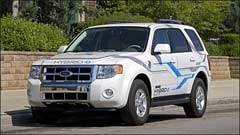The Ford Escape Plug-in Hybrid, which runs on gasoline or E85, is part of a demonstration fleet Ford is developing in a partnership with Southern California Edison and the Electric Power Research Institute. Advanced testing on the vehicles is underway in California. The Department of Energy will include the Escape Flexible Fuel Plug-in Hybrid in its fleet to showcase the marriage of technologies and obtain real world experience with the vehicle as it continues its support of advanced fuel technologies.
"Plug-in hybrid technology holds great promise to reduce the nation's dependence on petroleum and reduce CO2 emissions related to climate change, both significant issues for America," said Mark Fields, President of the Americas, Ford Motor Company. "As a leader in both hybrid and flexible fuel technology, Ford is well positioned to bring the two together in a plug-in vehicle."
The vehicle is equipped with a 10 kilowatt advanced lithium ion energy battery supplied by Johnson-Controls/Saft that stores enough electric energy to drive up to 30 miles at speeds of up to 40 mph. When fueled by E85 ethanol, which has a lower energy content than gasoline, fuel economy can reach up to 88 mpg in urban driving and up to 50 mpg on the highway. Based on current estimates, the vehicle would emit 60 percent less CO2 than a conventional gasoline powered vehicle. That CO2 reduction could reach 90 percent if cellulosic ethanol is used in place of gasoline.
The flexible fuel Escape Plug-in Hybrid runs up to 30 miles at speeds less than 40 mph in electric mode until the battery's charge is 70 percent depleted. At higher speeds or when the battery is depleted, the vehicle switches to traditional hybrid mode - a fuel-efficient four-cylinder engine assisted by the lithium ion battery. The vehicle leased to the DOE also is equipped with an innovative interactive vehicle display, which shows the driver how efficiently the vehicle is operating and calculates the fuel savings for each trip - part of Ford's efforts to help our customers drive smart and green.
"There is enormous interest in the country in the electrification of vehicles," Fields said. "We recognize commercialization of plug-ins, poweredby gasoline or biofuels, may represent part of a long-term energy solution,but significant challenges remain to bringing this technology to market."
This vehicle is one of 20 demonstration plug-in hybrids that Ford is building as part of a collaboration with Southern California Edison and the Electric Power Research Institute to accelerate the commercialization of plug-in hybrids. The partnership's goals include the development and creation of new business models to make plug-in hybrids possible; development of open architectures, standards and specifications; and a greater understanding of customer demand based on realistic expectations and customer usage needs
"We are moving from an independent set of solutions to an integrated future. With plug-in hybrids, the automotive and utility industries are connected by a common fuel with the potential to significantly change our transportation and energy future," said Nancy Gioia, director of Ford's Sustainable Mobility Technologies and Hybrid Vehicle Programs.
The first of the Escape Plug-in Hybrid SUV was delivered to Southern California Edison in December and road testing has begun. The vehicle delivered to the DOE today represents the first flexible fuel Escape Plug-in Hybrid developed as part of the partnership.

